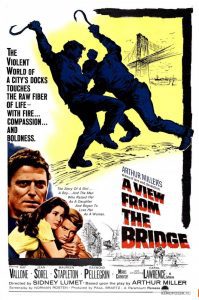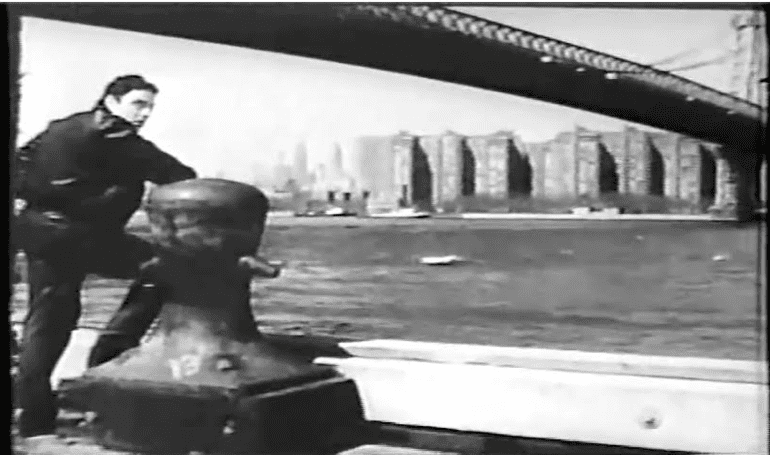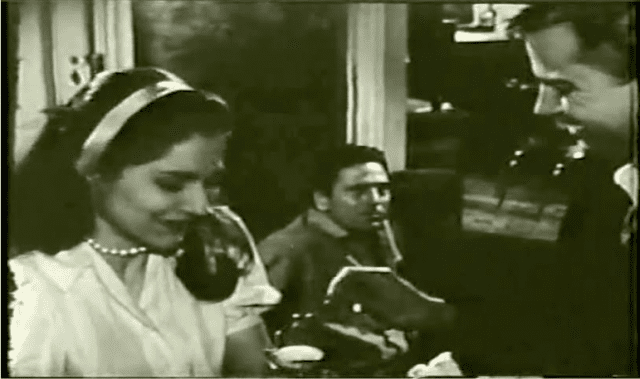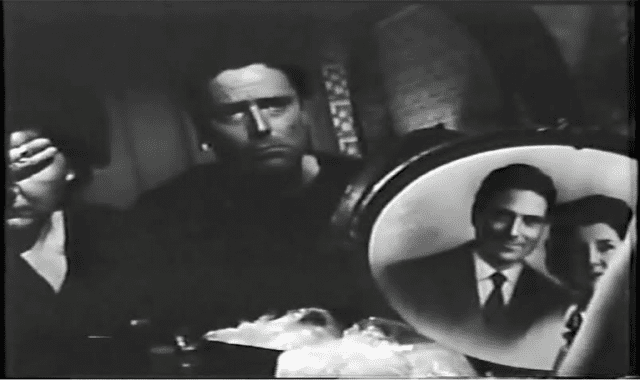A View from the Bridge is the story of an Italian American longshoreman named Eddie who informs on two of his wife’s relatives, illegal immigrants Marco and Rodolpho, in order to prevent Rodolpho from marrying his niece, Catherine. Critics of the film, and of the play by Arthur Miller on which it is based, have generally paid scant attention to the representation of migration in the story and as a result have often found the characters’ motives hard to read. Miller’s original inspiration for his “Italian tragedy” was the immediate post-WWII context, when he was immersed in the labor conflicts on the Brooklyn waterfront and made a trip to Italy to visit the families of Brooklyn longshoremen. Over the next 15 years, as is clear from many drafts of the story in the Ransom Center collection, Miller, Norman Rosten (who wrote the screenplay), and Lumet, shifted the emphasis to downplay the history of illegal Italian immigration.
This history begins in the 1920s when the United States passed a law that drastically limited the number of immigrants who could enter the United States from Italy (and elsewhere). But because crewmembers on ships arriving in American ports were given temporary shore leave, Italians began entering as sailors or as stowaways, who then remained in the United States permanently, often with the help of regular crew members. After WWII, when unemployment in Italy increased the pressure to emigrate,.immigration authorities saw these seaman-stowaways, known as “submarines,’ as a major problem. They began to screen crews for potential deserters and conduct targeted raids in immigrant communities (frequently based on tips from informants). Italian American longshoremen facilitated illegal immigration for various reasons. Some were smugglers and contractors who got the migrants off the ships and found them jobs as stevedores in exchange for portions of their pay. On the New York waterfront these fixers could function well because of the power of a longshoremen’s union to manipulate the hiring process and demand kickbacks. Around the same time Miller began working on A View From the Bridge, he wrote a screenplay also set on the Brooklyn waterfront that depicted the connection between the longshoremen’s union and illegal Italian immigration. In The Hook, a corrupt union boss attempts to maintain his power by forcing “submarines” to vote for him in a union election. Miller depicts the illegal immigrants as vulnerable, but not as passive or weak; once an Italian American longshoreman explains to them, in Italian, what is at stake—“Paisani! Is this the America you broke your backs to come to? We’re trying to live like human bein’s…We’re your brothers! We’ll protect you!…Dishonor on you if you steal my bread!…I have children! I am a family head!…You’re an honest worker, no?”—some of the submarines walk out of the union hall rather than vote against reform.
Early versions of the play that became A View from the Bridge, imply that Eddie himself may have originally come into the country as a submarine; he sees in Marco a version of his young self. The pre-film versions of the story also imply that Eddie is involved in smuggling immigrants. In these early versions, Eddie is nervous about the arrival of the cousins from the ship and his concern about informants in the neighborhood is not just dramatic irony but also fear given his own involvement in illegal immigration.
Dialogue in the earlier versions of the play conveys a fuller account of migration and the motives of the characters. After Eddie claims that many Italian men who return home after working for several years in America find their wives have had a couple more children in their absence, Marco insists that surprises like this are few. In one early version Beatrice insists that she knows half a dozen such men with two families. Eddie and Beatrice have two children in this version of the story and there is an implication, in Eddie’s defensiveness, that he might have another family abroad. In this version of the story, Rodolpho also frankly addresses the accusation that he is using Catherine to get citizenship in the United States. Refuting the binary either-or logic used by the immigration authorities to assess the intentionality of migrants and whether they are subverting the law, Rodolpho insists that he came to America seeking economic opportunity and wants to be a citizen so that he can work, but that he also sincerely fell in love with Catherine.
Rodolpho: What is this country—a prize? That you only win on your knees? I came to America to work. The same reason he [Eddie] wants to be an American. So I can make myself better before I die…You don’t trust me! You think I only want the papers…But there are no words to say this is a lie…it’s true, when I hold you I hold America also…But if I did not love you Catherine…then I could not have kissed you for a hundred Americas….I want to be an American so that I can work and eat; I want to be your husband so that I can love. It is the same thing, Catherine, there is nothing to deny. (He smiles tenderly—and sardonically): I kiss America.
Catherine: No, you’re kissing me; I know.
Rodolpho: Both . . . Both I love. Why not? It’s no crime.
In the late 1940s and early 1950s, Italian Americans quietly used marriage, adoption, and other family provisions to get around immigration restrictions. Alfieri, the attorney who narrates the story in all of the versions of Miller’s play, encapsulates the tentative and partial way that the established Italian American community challenged restrictionist immigration policy at midcentury. On the one hand, Alfieri insists that Rodolpho’s intention is unknowable and that it is no crime for him to desire to remain in the country permanently. Alfieri is also sympathetic to the desperate need to provide for a starving and sick family that drove Marco to immigrate illegally and to the hard work and sacrifices he has made since arriving. Alfieri offers to bail Marco out and delay his hearing so that he can work for a few more weeks and send additional money home. On the other hand, Alfieri doesn’t challenge Marco’s deportation—the law is the law. Alfieri accepts the divide between legal and illegal manners of entering the country. The best he can do is find selective relief in individual cases like Rodolpho’s that seem “natural” and demonstrate the ability of Italian immigrants to successfully and quickly assimilate. “We settle for half and I like it better that way,” Alfieri explains.
Lumet’s film version shifts the emphasis to focus on Eddie’s unruly emotions and threatened masculinity. The film is a story about illicit sexual desire, betrayal, and desolation, more than it is about migration and freedom. Eddie’s marriage with Beatrice is childless and sexless. Rodolpho’s passionate speech about his combined intentions is shortened. Lumet replaces the discussion of Italian women who wait and men having two families with a claustrophobic scene of the extended family around the dinner table (filmed from above and behind Eddie) and then in the crowded living room (with the camera focused on Beatrice and Marco as they watch Eddie), everyone reluctant to speak or to clap to the music lest Eddie erupt. What discussion there is revolves around Marco and Rodolpho’s travel on fishing boats before they came to America—a mobility in sharp contrast to the feeling of entrapment in the Red Hook apartment. While in the original play, Beatrice challenges a sexual double standard, she comes across in the film as simultaneously subordinated and nervous—using silly small talk as a means of defense—and demanding and unsympathetic to Eddie; she gets and takes much of the blame for all that happens. The scene in the apartment ends with Marco ominously holding a chair over Eddie’s head; Lumet captures, through paired, expressionistically lit close-ups, Eddie’s weakness and Marco’s strength. Eddie comes across as a beleaguered man trying to maintain a control as he loses it, which is emphasized by changing the ending to Eddie’s suicide (rather than his murder by Marco, as in Miller’s play).
Lumet’s Eddie has a lot more to lose than Miller’s. In the beginning of the film, Eddie is far removed from illegality, violence, and dishonesty as the opening scene on the docks makes clear. Eddie is presented as a man above the dockworkers, called upon to help settle disputes, a leader, close to elder lawyer, Alfieri. Eddie’s involvement with submarine smuggling is a thing of the past; the film makes no mention, as do all the other versions of the story, of any “syndicate.” Eddie asserts his distance from submarines, telling Catherine that he came into the country “in broad daylight, on a quota.” This word is used only in the film, not in versions of the story by Miller or Rosten. In the film, Eddie is more insistent that Catherine marry up, interact with “a better class of people,” work in a lawyer’s office in a neighborhood unlike Red Hook, and look and act like a college girl, all as a testament to Eddie’s sacrifice and respectability.
In the film, Eddie’s desire for Catherine is also about a desire for her Americanness. This is perhaps best captured in a scene that Lumet invents depicting Eddie watching Catherine and Rodolpho on a date at an automat. The sound in this scene is distinctive: as we watch Rodolpho work the machine and pile up Catherine’s tray, we hear the noise of the dishes and of the restaurant but not of the couple’s banter and laughter. This perfectly captures Eddie’s feeling of being privy to but apart from an American dream. Eddie feels challenged by Rodolpho not only because Catherine loves him but also because Rodolpho—dressed in newly purchased sharp clothes, interested in music and the movies—is better in tune with the emerging culture of consumption and leisure in postwar America. Alfieri and Beatrice frequently tell Eddie he must let go and make way for the next generation. He not only resents Catherine growing up, but feels threatened by Rodolpho’s soft masculinity. He feels out of step with the new social mores and sexual freedoms of the late 1940s that seemed to undermine his authority and that would provoke resentful backlash from men like him in the 1950s. Eddie feels rootless and estranged; Lumet frequently captures this in angled close ups that make Eddie seem ominous and trapped. He is unable to be the man he used to be (a struggling provider like Marco) or to become a new one, fit for changing times (a popular and open-hearted man like Rodolpho). Eddie’s kisses of Catherine and Rodolpho are passionate attempts to achieve potency. When that doesn’t work, Eddie turns informant; Lumet marks his walk to the telephone booth to call the immigration authorities with asynchronous beating sounds, giving a sense that Eddie is simultaneously determined and not in control. As Eddie makes the call, Lumet pans out to show him in a glass cage, emphasizing that his tragedy is social.
Miller’s original title for the story—“The Men from Under the Sea”—emphasized illegal immigrants and submarines but his final title shifted focus to a distant observation of Eddie’s unfolding tragedy; a view from above and afar. Given the differences between the film and Miller’s original conception, the bridge seems to signify separation rather than connection and emphasizes the distance between the audience and the action on stage and screen. By invoking myth and tragedy, Miller’s play depicts migration as fundamental and universal. But in the film, Eddie foists his insecurities and illicit desire onto the migrants. Lumet’s A View from the Bridge points to how migration prompts people to draw boundaries, divide, castigate, and scapegoat, and literally fight each other. The film begins and ends with shots of the hooks used to haul cargo off of ships; in this way, Lumet shows how Eddie turns a workingman’s tool into a weapon to use against Marco. Eddie associates illegality with being “a punk”—taking and spending selfishly rather than earning and providing; stealing what others have made through hard labor, dedication, and suffering. Though the slang term punk was a general epithetic diminutive by the post WWII period, it still retained sexual connotations. The word originated as term that referred to a physically slight youth who was used sexually by an older and more powerful man in exchange for money, frequently a prostitute on the waterfront. By the 1950s, calling someone a homosexual was akin to naming him a communist. In the film, Rodolpho’s refusal to keep his head down prompts Eddie’s desire to subordinate him and thereby prove his own dominance. The film shows how anti-immigrant sentiment has less to do with migrants and more to do with the people who resent them and images of what “good immigrants” should be. All versions of the story (the plays, the screenplay, and Lumet’s film) include a short scene where a longshoreman suggests to Eddie that “we oughta leave the country and come in under the water. Then we get work.” The implication is that illegal Italian immigrants unfairly have it better than Italian American workers. This divisive mentality is far from the solidarity glimpsed in The Hook. But the longshoreman’s line also shows that hatred of the other and desire to be the other are two sides of the same coin. In 1948, when jotting down his earliest notes about what would become A View from the Bridge, Miller wrote: “One of the main cements holding this country together is the fact that everybody thinks he is being persecuted…and they deny each other. It is a massive, impossibly complicated cancelation machine.”
Historical context and biographical clues helps explain the focus of the later versions of the play and the film. It makes sense that “the syndicate” is downplayed as Miller was wary of right wing attacks on union corruption, prominent in Congressional investigations in the 1950s and in Elia Kazan’s On the Waterfront (1954), which also heroized informants. Eddie, instead, is a tragic hero; Miller tries to portray what might drive someone to inform. Part of what drove Eddie to inform was illicit sexual passion, the same kind of passion that led Miller into an affair with Marilyn Monroe and ruined his marriage. Still, there was more driving Eddie, as is clear from his reference to the quota. By the 1960s, Italian American leaders were advocating for the abolition of the existing quota system to help relatives of Italian Americans emigrate, but endorsing a new ceiling on immigration from the Western Hemisphere, and, especially, Mexico. By the time Lumet’s film came out, Italians were, already, not most people’s idea of illegal immigrants.
Arthur Miller’s manuscripts referred to here can be found in The Harry Ransom Center, The University of Texas at Austin, Manuscript Collection MS-2831, container 6, folder 7; container 11, folders 13-14; and container 4, folder 3.
You may also like:
History Museums: Race, Eugenics, and Immigration in New York History Museums
Domesticating Ethnic Foods and Becoming American
Film Review of A Separation (2011)
Check out the schedule for our film series “Faces of Migration: Classic and Contemporary Films”
More on this year’s Institute for Historical Studies theme “Migration, Exile, and Displacement”



